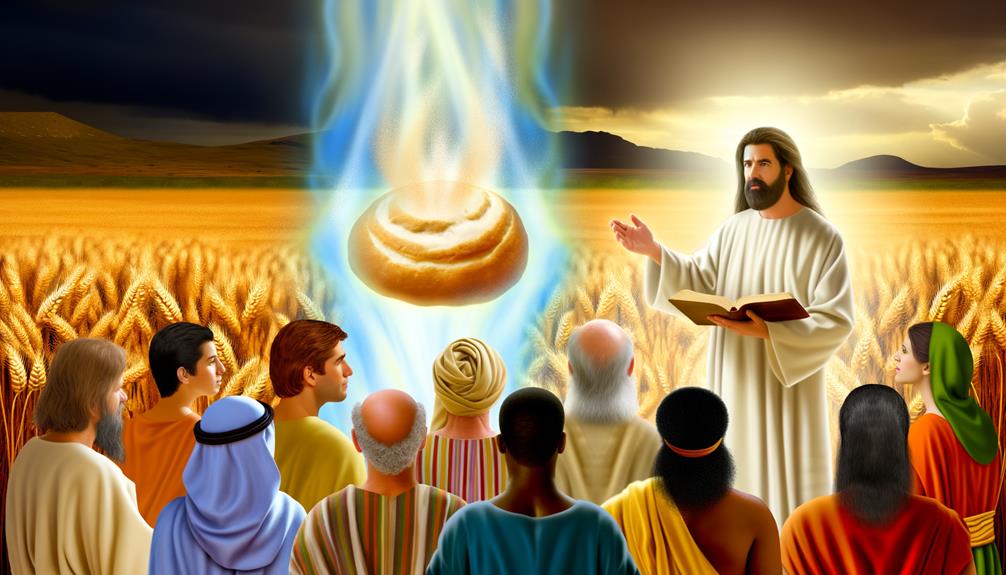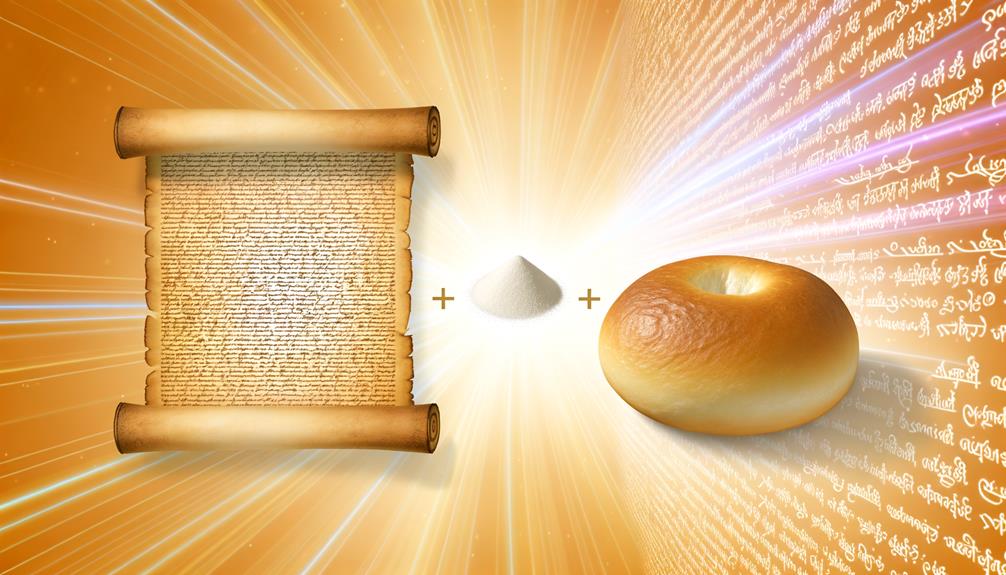Meaning of Yeast in the Bible: Influence and Growth
In the Bible, yeast, often referred to as leaven, symbolizes both corruption and spiritual purity depending on context. In the Old Scripture, it signifies sin and moral decay, leading to its removal during the Feast of Unleavened Bread (Exodus 12:15).
Conversely, Jesus’ parables in the New Scripture use yeast to illustrate the transformative and expansive nature of the Kingdom of Heaven (Matthew 13:33). The contrast between these portrayals of yeast highlights deeper theological themes of both impurity and divine influence in faith.
Exploring these passages provides greater insight into their profound spiritual meaning.

Key Takeaways
- Yeast symbolizes sin and moral corruption, particularly in the Old Testament (Exodus 12:15).
- Unleavened bread represents purity and obedience to divine commandments, especially during Passover.
- The removal of yeast during rituals signifies spiritual cleansing and the eradication of sin (Exodus 12:15-20).
- In the New Testament, yeast also metaphorically illustrates the Kingdom of Heaven’s subtle yet transformative growth (Matthew 13:33).
Yeast in Old Testament

In the Old Scripture, yeast, often referred to as leaven, holds significant theological and symbolic meaning, particularly in the context of Jewish rituals and laws.
Leaven is frequently mentioned in the Pentateuch, where it is often associated with corruption and impurity. For instance, in Exodus 12:15, the Israelites are commanded to remove leaven from their homes during the Feast of Unleavened Bread, symbolizing the eradication of sin and moral decay.
Leviticus 2:11 further prohibits the use of leaven in grain offerings made to Yahweh, reinforcing its symbolic representation of impurity.
The deliberate exclusion of leaven in sacred contexts underscores its negative connotations, reflecting a broader theological theme of purity and holiness within the Old Covenant narrative.
Symbolism of Unleavened Bread

Reflecting deep theological significance, the use of unleavened bread in biblical narratives often symbolizes purity, obedience, and separation from sin.
Scripturally, unleavened bread, or matzah, is prominently featured in the context of the Israelites’ exodus from Egypt (Exodus 12:15-20). Its preparation without yeast underscores a deliberate avoidance of fermentation, metaphorically representing the absence of corruption and moral decay.
Historically, the swift departure from Egypt necessitated bread made without leaven, which became a tangible reminder of divine deliverance and covenantal faithfulness.
Theologically, the consumption of unleavened bread commands adherence to God’s ordinances, reflecting a life purified from sin and aligned with divine instruction.
Consequently, unleavened bread serves as a profound emblem of spiritual integrity and divine obedience.
Yeast in Passover Tradition

The Passover tradition, as outlined in Exodus 12, emphasizes the removal of yeast from households, symbolizing purity and the haste of the Israelites’ departure from Egypt.
The historical context underscores the significance of unleavened bread, or matzah, as a tangible reminder of liberation and divine intervention.
Theologically, yeast is often interpreted as a metaphor for sin and corruption; therefore, its exclusion during Passover serves as an act of spiritual cleansing and renewal.
Symbolism of Unleavened Bread
Unleavened bread, a key element in the Passover tradition, symbolizes purity and separation from sin, reflecting the Israelites’ hasty departure from Egypt without time for their bread to rise.
Scripturally, leaven often represents corruption or impurity, contrasting with the sanctity required during the Passover (Exodus 12:15). The absence of yeast underscores a call to holiness, urging believers to remove sin from their lives, as Paul elucidates in 1 Corinthians 5:7, ‘Purge out consequently the old leaven, that ye may be a new lump.’
The Feast of Unleavened Bread hence becomes a profound metaphor for spiritual renewal, illustrating a divine mandate for moral and ritual purity as the faithful remember God’s deliverance.
Historical Context of Passover
Integral to understanding the historical context of Passover, yeast serves as both a practical and symbolic element, highlighting the Israelites’ urgent exodus from Egypt and the ensuing theological implications of purification and divine deliverance.
Scripturally, the command to use unleavened bread during Passover (Exodus 12:15-20) underscores the haste with which the Israelites departed, leaving no time for dough to rise.
Historically, this act commemorates not only the physical liberation from bondage but also a separation from corruption, as yeast, or leaven, often symbolizes sin and impurity in biblical texts.
The Feast of Unleavened Bread, consequently, is a ritualistic reflection of this duality, emphasizing both historical urgency and the aspirational purity required in the worship of Yahweh.
Spiritual Significance of Yeast
Yeast, within the Passover tradition, transcends its practical role to embody profound spiritual significance, symbolizing the pervasive nature of sin and the imperative for holiness in the life of believers. During Passover, leaven is meticulously removed from homes, reflecting the biblical mandate to purge sin from one’s life (Exodus 12:15). This ritual underscores the need for spiritual purity and readiness to follow God’s commandments.
| Aspect | Symbolism |
|---|---|
| Yeast | Sin’s pervasive influence |
| Unleavened bread | Purity and holiness |
| Removal of yeast | Repentance and cleansing |
| Passover | Liberation from bondage |
Scripturally, the removal of yeast is a call to introspection, urging believers to examine their lives and endeavor for moral integrity, as exemplified in 1 Corinthians 5:7.
Yeast in New Testament Parables

In the New Scripture, parables such as the Parable of the Leaven utilize yeast as a metaphor to illustrate the pervasive and transformative nature of the Kingdom of Heaven.
Found in Matthew 13:33 and Luke 13:20-21, this parable depicts a woman mixing yeast into flour until it permeates the entire batch.
Historically, yeast’s leavening effect was well-understood, symbolizing how the Kingdom’s influence spreads subtly yet powerfully through human hearts and society.
This theological insight underscores the Kingdom’s expansive reach, emphasizing small beginnings leading to extensive growth.
The use of yeast in these parables effectively conveys the unseen yet profound impact of divine presence and grace within the world, transforming it from within.
Yeast as a Sign of Sin

While yeast symbolizes the pervasive influence of the Kingdom of Heaven in some New Scriptures parables, it also frequently represents sin and corruption in biblical symbolism. Scripturally, yeast is often depicted as an agent of moral decay, as seen in the Old Covenant’s prohibition of leavened bread during Passover (Exodus 12:15). The Apostle Paul also invokes this imagery, admonishing believers to purge the ‘old leaven’ of malice and wickedness (1 Corinthians 5:7-8).
| Aspect | Interpretation |
|---|---|
| Yeast in Exodus | Symbol of sin to be removed |
| Leavened Bread | Represents impurity |
| Paul’s Admonition | Call to moral purity |
| Old Leaven | Malice and wickedness |
| Unleavened Bread | Sincerity and truth |
Thus, yeast serves as a potent metaphor for the insidious nature of sin.
Yeast and the Kingdom of Heaven

In the Gospel of Matthew, Jesus employs the Parable of the Yeast to illustrate the pervasive and transformative influence of the Kingdom of Heaven (Matthew 13:33).
Historically, yeast, though often symbolizing impurity, is here reinterpreted to signify positive spiritual growth and expansion.
Through this analogy, Jesus underscores the Kingdom’s subtle yet profound impact on individuals and communities, challenging conventional perceptions of spiritual influence.
Parable of Yeast
The Parable of the Yeast, found in the Gospel of Matthew 13:33, illustrates the transformative and pervasive nature of the Kingdom of Heaven through the metaphor of yeast causing dough to rise.
Jesus compares the Kingdom to yeast that a woman mixes into a large amount of flour until it permeates all the dough. Theologically, this underscores the subtle yet extensive influence of divine grace.
Historically, yeast was a common and potent agent of fermentation, symbolizing growth and change.
Scripturally, this parable aligns with the eschatological vision of an all-encompassing Kingdom. The yeast’s ability to leaven the entire batch signifies the expansive and inclusive reach of God’s reign, penetrating every aspect of human existence.
Yeast as Influence
Yeast, as a metaphor for influence within the biblical narrative, encapsulates the transformative power of the Kingdom of Heaven to permeate and fundamentally alter the spiritual and moral fabric of human society.
Historically, in Matthew 13:33, Jesus likens the Kingdom of Heaven to yeast mixed into flour until all of it is leavened. This scriptural analogy underscores the subtle yet pervasive impact of divine principles, suggesting that even small beginnings can lead to significant, all-encompassing change.
Theologically, yeast symbolizes the inward and often invisible workings of God’s influence, stressing the importance of seemingly minor actions and teachings that eventually lead to profound societal transformation.
Consequently, yeast represents the expansive nature of the Kingdom’s reach and its capacity for holistic renewal.
Spiritual Growth Symbolism
Building upon the metaphor of yeast as a transformative influence, its role in symbolizing spiritual growth within the context of the Kingdom of Heaven further illuminates the profound and incremental nature of divine expansion in the human soul.
In Matthew 13:33, Jesus likens the Kingdom of Heaven to yeast that a woman mixes into flour until it leavens the entire batch. This parable emphasizes the subtle yet pervasive influence of God’s kingdom, penetrating and transforming every aspect of life.
Historically, yeast’s ability to leaven bread, despite its small quantity, mirrors how the seemingly insignificant beginnings of spiritual faith can eventually lead to substantial and extensive growth within believers, reflecting the transformative power of divine grace.
Yeast in Jewish Rituals

In Jewish rituals, yeast holds significant symbolic meaning, particularly in the observance of Passover where its absence in unleavened bread underscores themes of purity and divine deliverance.
The commandment to consume matzah, or unleavened bread, during Passover (Exodus 12:15) serves as a tangible reminder of the Israelites’ swift departure from Egypt, leaving no time for bread to rise.
This ritualistic practice reflects a profound theological symbolism: the haste of liberation and the purity required for divine service.
Historically, the removal of chametz (leaven) from homes before Passover highlights a communal commitment to spiritual renewal.
Yeast, therefore, serves as a catalyst for reflection on the nature of deliverance and a recommitment to covenantal faithfulness.
Purity and Yeast in Scripture

Although yeast is a common element in daily life, its scriptural connotations often align with themes of purity and impurity, serving as a potent metaphor in biblical narratives.
In the Hebrew Bible, yeast (leaven) is frequently associated with corruption and sin. For instance, during the Feast of Unleavened Bread, Israelites were commanded to remove all yeast from their homes, symbolizing the eradication of moral and spiritual corruption (Exodus 12:15). This act underscored the necessity of maintaining purity before God.
Similarly, in the New Covenant, Jesus and Paul utilized yeast as a metaphor for pervasive sin or false teachings that could corrupt a community (Matthew 16:6, 1 Corinthians 5:6-8).
Consequently, yeast serves as a vivid emblem of purity’s importance in Scripture.
Yeast Metaphors in Christianity

Within the context of Christian theology, yeast metaphors are frequently employed to illustrate the transformative power of the Gospel and the pervasive nature of spiritual influence. The parable of the yeast in Matthew 13:33 emphasizes the Kingdom of Heaven’s subtle yet profound impact, likening it to yeast that leavens the whole dough. Historically, leavening has symbolized both positive and negative spiritual forces, creating a dual metaphor in scriptural analysis. This duality underscores the importance of vigilance in spiritual growth and purity.
| Positive Use | Negative Use |
|---|---|
| Kingdom of Heaven (Matt 13:33) | Hypocrisy of Pharisees (Luke 12:1) |
| Spiritual Growth (Gal 5:9) | Corruption (1 Cor 5:6) |
| Pervasive Influence (Matt 13:33) | Sin and Malice (1 Cor 5:6-8) |
Conclusion
The examination of yeast in biblical scripture reveals profound layers of theological significance and historical context.
This leavening agent, initially a symbol of sin and impurity, transforms into a metaphor for the Kingdom of Heaven, embodying growth and divine influence.
Intriguingly, its pervasive presence in both Jewish rituals and Christian teachings invites deeper reflection on purity and spiritual transformation.
Yet, one question lingers: how might contemporary faith communities reconcile these ancient symbols with modern spiritual practice?






